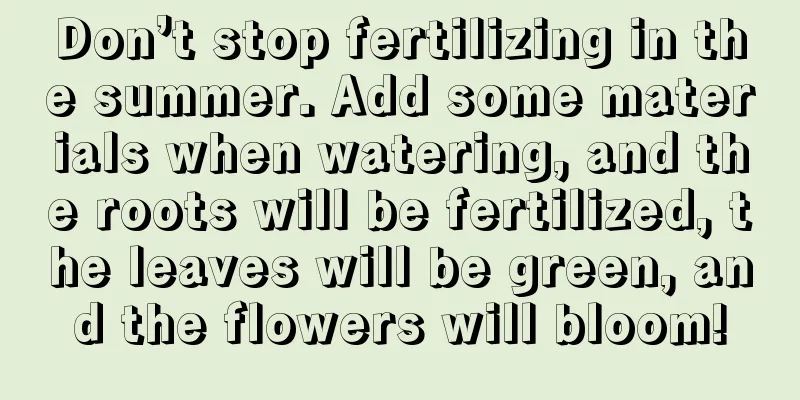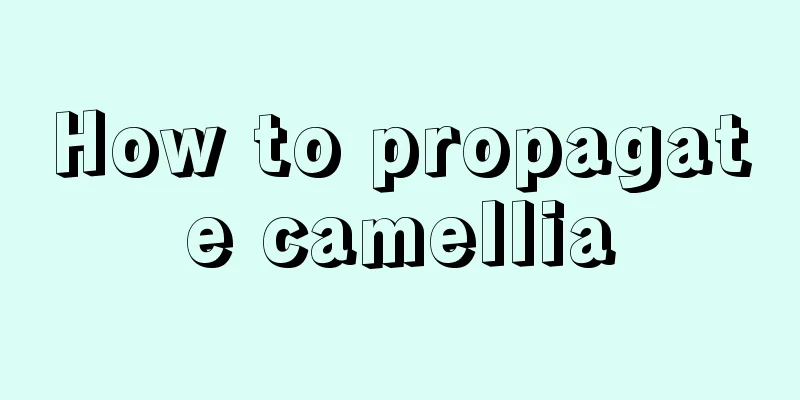Don’t stop fertilizing in the summer. Add some materials when watering, and the roots will be fertilized, the leaves will be green, and the flowers will bloom!

Summer topdressing 1: watering fertilizerThe temperature is high in summer, and solid fertilizers can easily burn the roots. If you are not careful, the leaves will turn yellow and dry up. Add liquid fertilizer diluted with clean water to water the flowers. The flower roots absorb quickly and with less irritation, which greatly reduces the risk of root burn! 1. Rice washing water (not smelly) The rice water must be decomposed first, poured into a plastic bottle and placed on the windowsill for 1-2 weeks, and then diluted with clean water (rice water: water = 1:500) to water the flowers. After rice washing water is decomposed, it becomes a natural organic nitrogen and phosphorus fertilizer. It can be used to water flowering and fruiting flowers. The leaves of green radish and pennywort will also grow bigger after using it. 2. Fruit peel water (no odor) In the summer, we eat a lot of fruits, and the leftover peels can be soaked in water to make fertilizer. Watermelon peel, melon peel, apple peel, tomato, cucumber, etc. can be chopped up and put into a plastic bottle. Add some water and put it in a well-lit place. Open it twice a week to let the air out, and it will be ripe after 20-30 days of fermentation. The fermented fruit fertilizer water is an acidic organic fertilizer. It can be used to water common flowers such as roses, Milan, gardenia, jasmine, hydrangea, etc. The hydrangea will slowly turn blue after watering. 3. Yogurt and egg shell fertilizer Don’t throw away expired yogurt or milk at home. Add 50ml of milk and 200ml of water and shake well. Prepare 1-2 egg shells, wash them, dry them, crush them, put them in the yogurt water and cover it with a lid. You also need to open the lid during the process to release the gas. If you are afraid of the smell, you can add some grapefruit peel to remove the smell. It takes about 2-3 weeks for yogurt and eggshell fertilizer to ferment. After fermentation, take 5-10 ml each time and mix it with water to water the flowers (fertilizer: water = 1:200). This fertilizer water mainly contains nitrogen and phosphorus elements, which is suitable for most flowering plants! Summer topdressing 2: hole fertilizerSome flowers are quite contradictory in summer. They don’t have enough nutrition and go dormant when the weather gets hot. They must be fed with some fertilizer. As long as the fertilizer is placed in the right place, there is no need to worry about the heat of the weather! 1. Raw eggshells Wash the raw egg shells and dry them in the sun. They are crispy and can be crushed easily. It is better to use raw eggshells for growing flowers, because the nutrients are not lost due to high temperatures. It is a good nitrogen fertilizer and can make the flowers grow stronger. If you have idle soil at home, you can add some eggshells to it and it will become nutritious soil after fermenting for 15-20 days. You can also sprinkle it directly on the soil next to the flowerpot and gently turn the soil over. This can avoid damaging the roots during fermentation and can also supplement nutrients. 2. Soybean dregs The dregs left over from making soy milk are also very good fertilizers, but they need to be decomposed. No need to drain the water, just put the dregs in a sealed box, cover it tightly and wait for 2-3 weeks to cook. After the bean dregs fertilizer is fermented, it should be buried along the edge of the pot. For flowers of normal size, 5-10g is enough. In summer, add it once a month, and the flowers will bloom bigger and last longer. Summer topdressing 3: base fertilizerWhen you need to repot the flowers at home or plant the newly bought flowers, it is a good opportunity to add fertilizer. Don’t forget to put a little fertilizer in it, it will save you a lot of trouble later! 1. Put some peanut shells at the bottom of the basin For flowers with thicker roots such as spider plants, clivias, cymbidiums, etc., it is suitable to add some peanut shells to the bottom of the pot. Not only are they breathable and water-permeable, but they can also be used as fertilizer. Putting them in once can last for 1-2 years! (Note that peanuts cannot have any flavor) 2. Professional slow-release fertilizer Flower lovers who don’t want to use traditional methods can also directly put some slow-release fertilizer at the bottom of the pot. This fertilizer is mild and putting it at the bottom of the pot in summer can help the flowers adapt to the pot faster. 3. Nails and bones to cushion the pelvic floor Our nails and other animal nails, such as cat nails, dog nails, horse shoes, cow shoes, etc., are rich in protein and calcium and are good base fertilizers. 4. Kitchen waste The kitchen waste at home can be used as base fertilizer if buried in the soil and fermented for 1-2 months. It is more nutritious than nutrient soil, and has little odor when buried in the soil. Flowers that use base fertilizer will bloom more and more vigorously! Universal flower lovers Do you have any other fertilization tips? You can also share it~ |
Recommend
The difference between Pyrus duli and Pyrus duli
1. Tree shape difference Pear is a tree with a he...
How to solve the problem of Schefflera falling leaves
1. Inappropriate light exposure Reason: Inadequat...
What is the best fertilizer for hydrangea?
Hydrangea fertilization time Hydrangeas can be fe...
How to fertilize colorful pineapple
The need for fertilizer Let’s talk about the soil...
If you come across these two kinds of "waste", take some home. The plants will benefit from eating them as coarse leaf fertilizer!
Winter has quietly entered the cold winter stage....
The main function of bear's paw wood
Main Function 1. Purify the air Bear's Paw Wo...
Breeding methods and precautions of high snow wheel
1. Breeding methods 1. Sunlight: Sufficient light...
How to grow Tangshan bamboo well
1. Soil suitability Choosing the right soil when ...
Where do coriander seeds come from?
Where do coriander seeds come from? There are two...
Cultivation methods and precautions of foxtail algae
1. Soil Foxtail Algae likes to grow in slightly a...
How to plant crabapple trees
1. Choose a pot When planting crabapple trees, ov...
Can pine red plum bloom in winter?
Normal flowering time of pine red plum They can b...
What kind of flowerpot is good for orchids
1. Size and Specifications First, generally speak...
If you grow a pot of this flower at home, the whole yard will be filled with fragrance when it blooms. It is most suitable for making pastries!
There is still some difference between sweet osma...
How to grow boxwood
1. Breeding methods 1. Soil: Boxwood grows well i...









